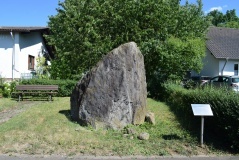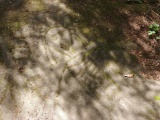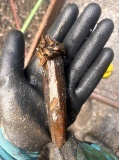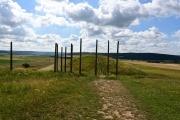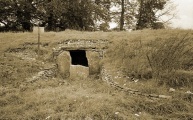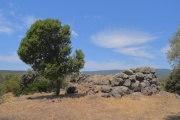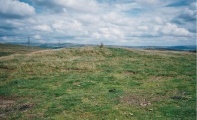Andy Burnham's Blog, page 15
July 25, 2025
Kindstein
Like many standing stones, this one is thought of as a fertility symbol according to local legend. It's on Zum Kindstein Street in a recent housing development south-west of the village of Unter-Widdersheimin near Frankfurt.
Published on July 25, 2025 06:41
July 24, 2025
Petroglyph Provincial Park (British Columbia)
This park was created to protect a high concentration of rock art sites, many thought to date back a thousand years. Many of the figures are beautiful depictions of sea creatures. It is a location of great significance for the Snuneymuxw First Nations people.
Published on July 24, 2025 09:08
Comox Estuary
Rare 3,800-year-old waterlogged archaeological site with ancient organic artefacts uncovered in K’ómoks territory, British Colombia. Many mudflats on tidal estuaries of the Johnstone Strait have evidence of wood and stone fish traps and clam gardens which were originally built up to 1700 years old. Wooden stakes, shaped by stone tools, were driven into the mudflats to form short stockade-like traps to catch fish as the tide went out. Radiocarbon dating indicates the same basic structures have been built and used up into historic times.
Published on July 24, 2025 08:51
July 22, 2025
Glauberg Fürstengrabhügel
An Iron Age oppidum NE of Frankfurt consisting of a fortified settlement and several burial mounds. This chieftain's tomb dating to about 500 BCE was excavated in 1990 after aerial photography revealed interesting patterns. The posts in the excavated post-holes were reconstructed in 2007. Among other items, a life size limestone statue of a warrior with an unusual helmet was found that we featured a few days ago. The mound is surrounded by ditches which may have been processional paths. The statues were found buried in the ditch. These ditches lead to comparisons with Tara in Ireland.
Published on July 22, 2025 11:25
July 21, 2025
Le Quesnel Menhir
Standing over 4m tall on the La Moye headland, this standing stone was destroyed in the 19th century. It was most likely victim to quarrying, broken up with the stones that were left of its enclosure soon after 1870. There was an awareness at the time it would soon be destroyed, the illustration is by a Lieutenant S.P Oliver who described the situation in a 1870 report.
Published on July 21, 2025 10:33
Lanhill
This lesser known but wonderful long barrow lies behind a hedgerow to the south of the A420 just outside Chippenham, seen here in a photo from 1972. The external dry stone walling is very likely a reconstruction. The barrow was damaged when a false entrance was removed in 1909, but the mound is still 56m long and nearly 4m high. There were three burial chambers, only one on the south side survives.
Published on July 21, 2025 08:00
July 20, 2025
Tronza Protonuraghe
An example of a corridor nuraghe. The monument is located 1km NE of Milis, near the eastern bank of Riu Mannu. The walls survived up to 5m of height, the best preserved part of the structure is at the north.
Published on July 20, 2025 13:06
Fordcroft Romano-British Bathhouse
On Sunday 20th July I visited the open day of the Romano-British Bathhouse near Orpington. There was an interesting little tour and also an exhibition in the nearby Coronation hall with many Roman and other artefacts. This site is only open a couple of times a year including for the Festival of British Archaeology so I was pleased to chat with the volunteers. It's in St Mary Cray, SE London. With knowledgable members of Orpington and District Archaeological Society (ODAS) in attendance showing how they know it to be a bath house.
Published on July 20, 2025 10:00
July 18, 2025
Keltenwelt am Glauberg
A life-sized sandstone statue dating to the 5th century BC found outside the larger tumulus at Glauberg, NE of Frankfurt. An armed male warrior wearing a torc, and a hood-like headdress with protrusions resembling a mistletoe leaf. This is thought to have held a magical significance to the 'Celts' so this could indicate the warrior had a religious role. This museum and archaeological park presents finds and sites of the Celts dating from late Hallstatt and early La Tene periods. The main attraction is the tumulus of the Lord of Glauberg (ca. 500 BC).
Published on July 18, 2025 10:39
July 16, 2025
Hunger Hill Cairn
A new longform video from Tales From Trails Around The Dales: Ancient Burials, exploring the ancient barrows on the hills and moors above Rochdale, some barely visible in the landscape, view from the comments section on our page. A cairn at the north end of Hunger Hill to the north of Rochdale at 307 metres above sea level, with commanding views from the site.
Published on July 16, 2025 09:31

